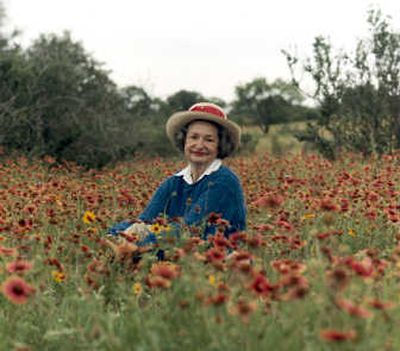Love of flowers inspired advocacy

AUSTIN, Texas – When you see a pretty vista along an interstate highway, unmarred by a junkyard or a billboard telling you to Eat at Joe’s, you can thank Lady Bird Johnson.
Johnson loved nature and Texas wildflowers, and her devotion to the beauty and usefulness of native plants may well be the former first lady’s biggest legacy.
Breaking ground as an activist first lady, she pressed for cleanup efforts in the nation’s capital and had a key role in lobbying for the passage of the Highway Beautification Bill in 1965. The $320 million bill became known as “The Lady Bird Bill.”
According to the Federal Highway Administration’s account, the first lady was particularly incensed by what she saw while traveling to campaign stops during the 1964 election. On a stop in Portland in September 1964, the president said the auto junkyards they had seen during the campaign “are driving my wife mad.”
The bill, signed Oct. 22, 1965, provided incentives to reduce the number of billboards and remove or shield other ugly sights along federal highways. Planting wildflowers and other native plants along highways – already a well-established program in Texas – was expanded.
Johnson showed her love of flowers in other ways, both in the White House and afterward. She commissioned a china service for the White House that featured dozens of different wildflowers, including the official flowers of the 50 states.
On her 70th birthday, in 1982, she and actress Helen Hayes founded the National Wildflower Research Center in Austin. It was later renamed the Lady Bird Johnson Wildflower Center.
Its purpose is to encourage people to understand, love and preserve the natural beauty of the nation’s landscape. Plants unique to central Texas ecosystems are featured at the center and are displayed in gardens and natural areas.
The center, which operates on private donations, along with grants and admission fees, also has on its grounds a rainwater collection and storage system, recycled building materials, American folk art and educational facilities.
“This is her great joy and passion in life,” former executive director Robert Breunig once said.
Lady Bird Johnson said she founded the wildflower center to educate people about the environmental necessity, economic value and natural beauty of native plants.
“Our center works for more than the lovely blossoms in our open spaces,” Johnson wrote in a message on the center’s Web site. “We are concerned for all of North America’s native plants, from the smallest sprout to the tallest tree.”